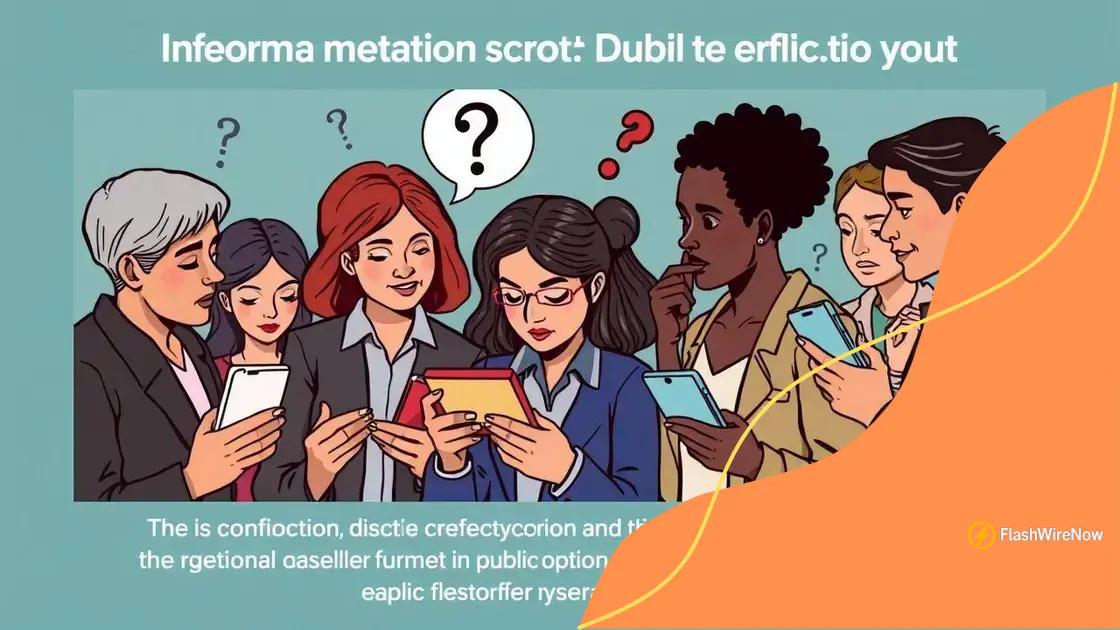Analyzing online disinformation campaigns: what to know

Anúncios
Analyzing online disinformation campaigns helps individuals identify false information, understand the tactics used, and implement best practices to promote accurate content and media literacy in their communities.
Analyzing online disinformation campaigns is crucial in today’s digital age. With misinformation spreading rapidly, it’s essential to understand how these campaigns shape perceptions and influence behavior. Let’s dive into their key components.
Anúncios
Understanding online disinformation
Understanding online disinformation is crucial in our information-saturated world. As false narratives spread across platforms, recognizing their origins and motivations becomes vital.
What is Online Disinformation?
Online disinformation refers to deliberately misleading or false information spread via the internet. It often aims to manipulate public perception or behavior, utilizing various tactics to deceive audiences. Understanding this phenomenon helps individuals navigate the digital landscape more effectively.
Common Tactics Used in Disinformation
- Emotional Appeals: Disinformation often targets emotions to influence opinions.
- Fabricated Sources: Reliable-looking sources are created to lend credibility to false information.
- Manipulated Images: Altered images can be used to reinforce misleading claims.
- Echo Chambers: Repetition within closed groups amplifies the spread of disinformation.
By recognizing these tactics, individuals can better protect themselves against falling victim to misleading narratives. Misleading information can sow confusion and division, making it imperative to scrutinize the content consumed online. One tool for combating online disinformation is fact-checking. When encountering suspicious claims, checking multiple sources can help clarify the truth. Staying informed about current tactics used by disinformation campaigns can also strengthen one’s critical thinking skills.
Anúncios
Furthermore, the rise of social media has amplified the spread of disinformation. With algorithms prioritizing engagement over accuracy, people may unknowingly share false content with their networks. It’s essential to engage thoughtfully with online material and encourage others to do the same. As users, we have the power to challenge misleading narratives by sharing accurate information and fostering discussions based on fact.
Common tactics used in disinformation campaigns
Common tactics used in disinformation campaigns can be quite deceptive and are designed to manipulate public opinion. By understanding these tactics, individuals can better recognize and combat the spread of misinformation.
Fabrication of Stories
One prevalent tactic is the invention of entirely false stories. These are often designed to provoke emotional responses, making them more likely to be shared. For example, fake news articles may pose sensational headlines that spread quickly across social media.
Cherry-Picking Evidence
Another tactic involves picking specific pieces of information that support a particular viewpoint while ignoring contradictory data. This selective presentation can mislead audiences and create a distorted perception of reality.
- Manipulative Statistics: Using data in misleading ways enhances arguments.
- Out-of-Context Quotes: Quoting someone without context changes the intended meaning.
- Visual Misleading: Altering images or using stock photos can create false narratives.
These tactics exploit cognitive biases, making it easier for people to believe and share false information. In addition, the use of bots and fake accounts further amplifies disinformation. These automated tools help spread false narratives rapidly and can make misinformation seem more prevalent than it actually is.
Furthermore, emotionally charged content is often prioritized due to its higher engagement rates. This leads to a cycle where sensationalized false claims receive more visibility than nuanced truth. To counter this, it’s essential to verify claims before sharing information online. Education on identifying disinformation campaigns and their common tactics is vital for fostering a more informed public.
Effects of disinformation on public opinion

The effects of disinformation on public opinion can be profound and far-reaching. As false information spreads, it influences perceptions, behaviors, and ultimately decision-making processes.
Altered Perceptions
One significant effect is the alteration of community perceptions. When a group is exposed to biased or misleading information, their views can shift dramatically, creating divisions among individuals. These shifts often happen without people realizing it. This is especially true in politically charged environments where disinformation can shape voter behavior and opinions significantly.
Decreased Trust
Another notable impact is a decline in trust towards traditional media and institutions. As people encounter increasing amounts of disinformation, they may begin to question the credibility of reputable sources. This skepticism can lead to a general distrust of media, which ultimately harms informed discourse.
- Polarization: Disinformation often leads to increased polarization between different groups.
- Manipulation of Emotions: By exploiting emotions, disinformation can push people towards extreme viewpoints.
- Public Confusion: Unclear facts create confusion, leading to uncertainty in decision-making.
The emotional manipulation inherent in many disinformation campaigns can also polarize communities. When individuals are exposed to information that confirms their existing beliefs, it enhances their emotional responses, often pushing them to the extremes of their viewpoints. This causes debates to become more hostile and less constructive.
Moreover, the confusion that arises from the mixed messages of disinformation can lead to difficulty in making informed decisions. For example, misinformation about health can affect how people respond to medical advice or treatments. It’s essential to understand that the implications of disinformation go beyond individual opinions; they can impact societal norms and relationships.
How to identify false information online
Identifying false information online is crucial for navigating today’s digital landscape. With so much content available, recognizing what is trustworthy can be challenging. Fortunately, there are strategies you can use to spot false information.
Check the Source
Start by examining the source of the information. Reliable sources tend to have established credibility. Look for well-known news organizations, academic institutions, or official government websites. If the source is unfamiliar, a quick online search can help determine its trustworthiness.
Look for Evidence
Also, consider whether the claims made in the article or post are supported by evidence. Credible information often includes references to studies, expert opinions, or data. If an article lacks supporting information or relies on exaggerated claims, it may not be reliable.
- Verify the Date: Ensure the information is current. Outdated facts can mislead.
- Cross-Check Information: Look for the same story on multiple reliable sources.
- Examine the Author: Research the author to see if they have expertise in the subject matter.
Furthermore, pay attention to the language used in the article. Sensationalist headlines or emotionally charged wording can be red flags. Reliable articles typically maintain a neutral tone, providing balanced viewpoints rather than pushing a particular agenda. Being aware of these factors will help you avoid sharing false information.
It’s also helpful to utilize fact-checking websites. Sites like Snopes, FactCheck.org, and others can verify claims that seem questionable. When in doubt, consult these resources before acting on the information. By developing good habits for evaluating information, you can significantly reduce the risk of falling for misinformation.
Best practices for combating disinformation
Combating disinformation requires a proactive approach and awareness. By adopting best practices, individuals can help to reduce the spread of false information and promote a healthier information environment.
Stay Informed
First, make sure to stay informed about the latest trends in disinformation. Understanding common tactics helps you recognize misinformation when you see it. Being familiar with the types of disinformation can prepare you to respond appropriately.
Engage in Media Literacy
Media literacy involves learning how to analyze and evaluate media content critically. This includes understanding the context of information and recognizing biases. Consider taking workshops or online courses that focus on improving your media literacy skills.
- Verify Sources: Always check the credibility of sources before sharing information.
- Consult Fact-Checkers: Use reputable fact-checking websites to verify suspicious claims.
- Analyze the Content: Look for evidence that supports claims made in the articles or posts.
Additionally, promoting healthy online habits can make a significant difference. Encourage discussions about critical thinking and healthy skepticism when it comes to sharing news and information. When engaging with content, take a moment to think critically about what you read. Ask yourself if the information seems credible and whether it aligns with what you know to be true.
Furthermore, when you encounter disinformation, consider reporting it. Many social media platforms have options for reporting false information. By doing so, you contribute to a larger community effort against misinformation and help protect others from being misled.
Lastly, share quality content that you have verified. Promote accurate information through your social networks. By sharing trustworthy facts and research, you can help counteract misleading narratives. These best practices lead to an informed community that values truth and transparency.
FAQ – Frequently Asked Questions about Combating Disinformation
What are some common tactics used in disinformation campaigns?
Common tactics include fabricating stories, cherry-picking evidence, and manipulating images to mislead audiences.
How can I identify false information online?
Check the source, verify claims with reputable fact-checkers, and look for supporting evidence.
Why is media literacy important in combating disinformation?
Media literacy enables individuals to analyze and evaluate information critically, helping them to distinguish between credible and false content.
What can I do to promote accurate information in my community?
Share verified content, encourage discussions about misinformation, and engage in media literacy workshops to foster a more informed community.





